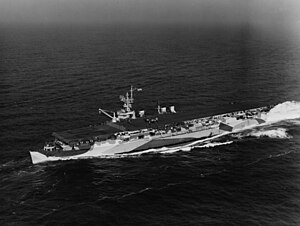Independence-class aircraft carrier

USS San Jacinto on a training cruise off the east coast in 1944
|
|
| Class overview | |
|---|---|
| Builders: | New York Shipbuilding |
| Operators: | |
| Succeeded by: | Saipan-class aircraft carrier |
| Completed: | 9 |
| Lost: | 1 |
| Retired: | 8 |
| Preserved: | 0 |
| General characteristics | |
| Type: | Light aircraft carrier |
| Displacement: | 11,000 tons (standard) |
| Length: | 622 ft 6 in (190 m) |
| Beam: |
|
| Propulsion: |
|
| Speed: | 31.5 knot (36 mph 58 km/h) maximum |
| Armament: | 26 × Bofors 40 mm guns |
| Aircraft carried: |
|
The Independence-class aircraft carriers were a class of light carriers built for the United States Navy that served during World War II.
Adapted from the design for Cleveland-class light cruisers, this class of ship resulted from the interest of President Franklin D. Roosevelt in naval air power. With war looming, the former Assistant Secretary of the Navy noted no new fleet aircraft carriers were expected to be completed before 1944. He proposed to convert some of the many cruisers then under construction to carriers. Studies of cruiser-size aircraft carriers had shown the type had serious limitations, and on 13 October 1941, the General Board of the United States Navy replied that such a conversion showed too many compromises to be effective.
Undeterred, President Roosevelt ordered another study. On 25 October 1941, the Navy's Bureau of Ships reported that aircraft carriers converted from cruiser hulls would be of lesser capability, but available much sooner. After the December 1941 attack on Pearl Harbor, the need for more carriers became urgent. The Navy accelerated construction of the 34,000 ton Essex-class aircraft carriers, but these large ships could not be finished quickly. So in January 1942, the Navy also ordered that a Cleveland-class light cruiser then under construction be completed instead as a light aircraft carrier. It became the USS Belleau Wood (CVL-24), the first ship of the Independence-class.
Plans developed for this conversion showed much more promise than expected. Two more light cruisers were reordered as carriers in February, three more in March, and a final three in June 1942. The Independence-class design had a relatively short and narrow flight deck and hangar, with a small island. The hangar, flight deck, and island represented a significant increase in the ship's topside weight. To compensate for this, blisters were added to the original cruiser hull, which increased the original beam by five feet. Ships of this class carried a small air group - only about 30 aircraft. This was originally set to consist of nine fighters, nine scout bombers, and nine torpedo bombers, but later revised to about two dozen fighters and nine torpedo bombers.
...
Wikipedia
